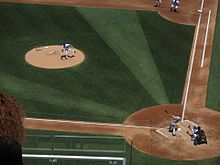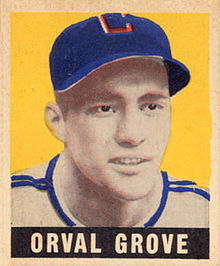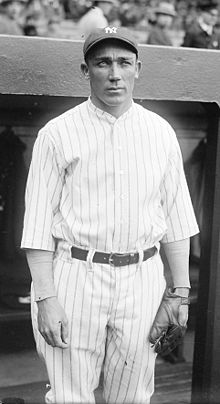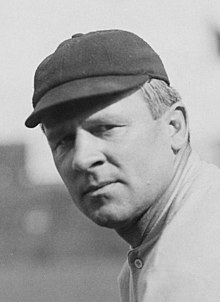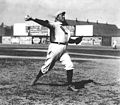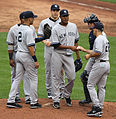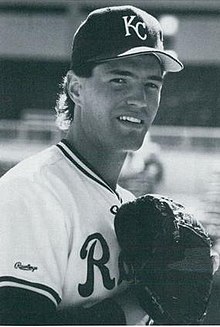Portal:Baseball
Portal maintenance status: (June 2018)
|
| Main page | Content, Categories & Topics | WikiProjects & Things you can do |
The Baseball Portal
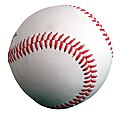
Baseball is a bat-and-ball sport played between two teams of nine players each, taking turns batting and fielding. The game occurs over the course of several plays, with each play generally beginning when a player on the fielding team, called the pitcher, throws a ball that a player on the batting team, called the batter, tries to hit with a bat. The objective of the offensive team (batting team) is to hit the ball into the field of play, away from the other team's players, allowing its players to run the bases, having them advance counter-clockwise around four bases to score what are called "runs". The objective of the defensive team (referred to as the fielding team) is to prevent batters from becoming runners, and to prevent runners advancing around the bases. A run is scored when a runner legally advances around the bases in order and touches home plate (the place where the player started as a batter).
The opposing teams switch back and forth between batting and fielding; the batting team's turn to bat is over once the fielding team records three outs. One turn batting for each team constitutes an inning. A game is usually composed of nine innings, and the team with the greater number of runs at the end of the game wins. Most games end after the ninth inning, but if scores are tied at that point, extra innings are usually played. Baseball has no game clock, though some competitions feature pace-of-play regulations such as the pitch clock to shorten game time.
Baseball evolved from older bat-and-ball games already being played in England by the mid-18th century. This game was brought by immigrants to North America, where the modern version developed. Baseball's American origins, as well as its reputation as a source of escapism during troubled points in American history such as the American Civil War and the Great Depression, have led the sport to receive the moniker of "America's Pastime"; since the late 19th century, it has been unofficially recognized as the national sport of the United States, though in modern times is considered less popular than other sports, such as American football. In addition to North America, baseball spread throughout the rest of the Americas and the Asia–Pacific in the 19th and 20th centuries, and is now considered the most popular sport in parts of Central and South America, the Caribbean, and East Asia, particularly in Japan, South Korea, and Taiwan. (Full article...)
 Featured articles - load new batch
Featured articles - load new batch
-
Image 1

Lawrence Winchester Wetherby (January 2, 1908 – March 27, 1994) was an American politician who served as Lieutenant Governor and Governor of Kentucky. He was the first of only two Kentucky governors born in Jefferson County, despite the fact that Louisville (the county seat) is the state's most populous city. The second governor born in Jefferson County is the incumbent governor, Andy Beshear, who grew up in the Lexington area. Two other governors have been elected when residents of Jefferson: Augustus Willson, 1907-11, and Matt Bevin, 2015-19.
After graduating from the University of Louisville, Wetherby held several offices in the Jefferson County judicial system before being elected lieutenant governor in 1947 as the choice of 2nd District U.S. Rep. Earle C. Clements, D-Morganfield, who won the primary for the top job. Wetherby was called Kentucky's first "working" lieutenant governor because Clements had him to carry out duties beyond his constitutional responsibility to preside over the state Senate, such as preparing the state budget and attending the Southern Governors Conference. In 1950, Clements was elected to the U.S. Senate, elevating Wetherby to governor. Wetherby won immediate acclaim by calling a special legislative session to increase funding for education and government benefits from the state's budget surplus. In 1951, campaigning as a "Middletown farmer" in a largely rural state, he won a four-year full term as governor, during which he continued and expanded many of Clements' programs, including increased road construction and industrial diversification. He endorsed the Supreme Court's 1954 desegregation order in the case of Brown v. Board of Education and appointed a biracial commission to oversee the successful integration of the state's schools. As chairman of the Southern Governors Conference in 1954 and 1955, he encouraged other Southern governors to accept and implement desegregation. (Full article...) -
Image 2
Orval Leroy Grove (August 29, 1919 – April 20, 1992) was an American professional baseball pitcher in Major League Baseball who played for ten seasons in the American League with the Chicago White Sox. In 207 career games, Grove pitched 1,176 innings and posted a win–loss record of 63–73, with 66 complete games, 11 shutouts, and a 3.78 earned run average (ERA).
The only freshman on the Proviso Township High School varsity baseball team, Grove's pitching ability attracted the attention of the White Sox. After signing with the team in 1937, Grove moved between the major leagues and minor leagues for a few seasons until 1943, when he found a solid place in the White Sox's pitching rotation. Grove had a career-year in 1943, finishing the season with career-bests in ERA, wins, and complete games; in 1944, he made his only All-Star appearance. (Full article...) -
Image 3

Depiction of the game from The Boston Globe
On Saturday, May 1, 1920, the Brooklyn Dodgers and the Boston Braves played to a 1–1 tie in 26 innings, the most innings ever played in a single game in the history of Major League Baseball (MLB). The game was played at Braves Field in Boston before a crowd estimated at 4,000. Both Leon Cadore of Brooklyn and Joe Oeschger of Boston pitched complete games, and with 26 innings pitched, jointly hold the record for the longest pitching appearance in MLB history. Their record is considered unbreakable, as modern pitchers rarely pitch even nine innings, and newer baseball rules have made long extra-innings games a rarity.
The day of the game saw rainy weather, and it was uncertain if the game would be played, but the skies cleared enough to allow it to proceed. Brooklyn scored a run in the fifth inning, and Boston in the sixth; thereafter, the pitchers became increasingly dominant. As the game exceeded eighteen innings, the small crowd at Braves Field cheered both pitchers. The last twenty innings were scoreless, and when darkness started to fall, the umpires called a halt after the twenty-sixth inning, as baseball fields did not yet have artificial lighting. (Full article...) -
Image 4
Kenesaw Mountain Landis (/ˈkɛnɪsɔː ˈmaʊntɪn ˈlændɪs/; November 20, 1866 – November 25, 1944) was an American jurist who served as a United States federal judge from 1905 to 1922 and the first commissioner of baseball from 1920 until his death. He is remembered for his resolution of the Black Sox Scandal, in which he expelled eight members of the Chicago White Sox from organized baseball for conspiring to lose the 1919 World Series and repeatedly refused their reinstatement requests. His iron rule over baseball in the near quarter-century of his commissionership is generally credited with restoring public confidence in the game.
Landis was born in Millville, Ohio. Raised in Indiana, he became a lawyer, and then personal secretary to Walter Q. Gresham, the new United States Secretary of State, in 1893. He returned to private practice after Gresham died in office. (Full article...) -
Image 5

On July 10, 1932, the Philadelphia Athletics beat the Cleveland Indians 18–17 in 18 innings in a Major League Baseball game played at League Park in Cleveland. Several major-league records were set during the game; for example, Johnny Burnett of the Indians became the only player to hit safely nine (or even eight) times in a game, while Cleveland's 33 hits and the teams' combined 58 hits are also single-game records. Pitcher Eddie Rommel secured the win for the Athletics, pitching an American League-record 17 innings in relief after Philadelphia's Lew Krausse gave up three runs in the first inning. The 29 hits Rommel allowed are a major-league record; the 14 runs against him are the most given up by a winning pitcher.
Coming into the game, the Athletics, who were the three-time defending American League champions, trailed the New York Yankees in the standings by 71⁄2 games. Sunday baseball was still illegal in Philadelphia, forcing the Athletics to make one-game road trips on some Sundays, including July 10. With his pitching staff exhausted by six games in the previous three days, the owner and manager of the Athletics, Connie Mack, took only two pitchers on the train trip to Cleveland, giving the rest of the staff the day off. With no chance of being relieved except by a position player, Rommel pitched with mixed effectiveness, giving up six runs in the seventh inning but only two runs in the final nine innings of the game. He aided his own cause by getting three hits in seven at bats. Cleveland's Wes Ferrell took the loss after Jimmie Foxx got his sixth hit of the game and then scored. Foxx had already batted in eight runs, having hit three home runs and accumulated sixteen total bases, tying a record that has since been broken. (Full article...) -
Image 6The 2004 World Series was the championship series of Major League Baseball's (MLB) 2004 season. The 100th edition of the World Series, it was a best-of-seven playoff between the American League (AL) champion Boston Red Sox and the National League (NL) champion St. Louis Cardinals; the Red Sox swept the Cardinals in four games. The series was played from October 23 to 27, 2004, at Fenway Park and Busch Memorial Stadium, broadcast on Fox, and watched by an average of just under 25.5 million viewers. The Red Sox's World Series championship was their first since 1918, ending the Curse of the Bambino.
The Cardinals earned their berth into the playoffs by winning the NL Central division title, and had the best win–loss record in the NL. The Red Sox won the AL wild card to earn theirs. The Cardinals reached the World Series by defeating the Los Angeles Dodgers in the best-of-five NL Division Series and the Houston Astros in the best-of-seven NL Championship Series. The Red Sox defeated the Anaheim Angels in the AL Division Series. After trailing three games to none to the New York Yankees in the AL Championship Series, the Red Sox came back to win the series, advancing to their first World Series since 1986. The Cardinals made their first appearance in the World Series since 1987. With the New England Patriots winning Super Bowl XXXVIII, the World Series victory made Boston the first city to have Super Bowl and World Series championship teams in the same year (2004) since Pittsburgh in 1979. The Red Sox became the third straight wild card team to win the World Series; the Anaheim Angels won in 2002 and the Florida Marlins won in 2003. (Full article...) -
Image 7
Osborne Earl Smith (born December 26, 1954) is an American former professional baseball player. Nicknamed "The Wizard of Oz", Smith played shortstop for the San Diego Padres and St. Louis Cardinals in Major League Baseball, winning the National League Gold Glove Award for defensive play at shortstop for 13 consecutive seasons. A 15-time All-Star, Smith accumulated 2,460 hits and 580 stolen bases during his career, and won the National League Silver Slugger Award as the best hitter at shortstop in 1987. He was elected to the Baseball Hall of Fame in his first year of eligibility in 2002. He was also elected to the St. Louis Cardinals Hall of Fame in the inaugural class of 2014.
Smith was born in Mobile, Alabama; his family moved to Watts, Los Angeles, when he was six years old. While participating in childhood athletic activities, Smith possessed quick reflexes; he went on to play baseball at Locke High School in Los Angeles, then at California Polytechnic State University, San Luis Obispo. Drafted as an amateur player by the Padres, Smith made his major league debut in 1978. He quickly established himself as an outstanding fielder, and later became known for performing backflips on special occasions while taking his position at the beginning of a game. Smith won his first Gold Glove Award in 1980 and made his first All-Star Game appearance in 1981. (Full article...) -
Image 8

James Robert "Loafer" McAleer (July 10, 1864 – April 29, 1931) was an American center fielder, manager, and stockholder in Major League Baseball who assisted in establishing the American League. He spent most of his 13-season playing career with the Cleveland Spiders, and went on to manage the Cleveland Blues, St. Louis Browns, and Washington Senators. Shortly before his retirement, he became a major shareholder in the Boston Red Sox. His career ended abruptly. During his brief tenure as co-owner of the Red Sox, McAleer quarreled with longtime friend and colleague Ban Johnson, president of the American League. In the wake of this disagreement, he sold off his shares in the Red Sox and broke off his relationship with Major League Baseball.
McAleer's rift with Johnson, along with his sudden retirement, damaged his professional reputation, and he received little recognition for his contributions to baseball. Today, he is most often remembered for initiating the customary request that the President of the United States throw out the first ball of the season. (Full article...) -
Image 9Los Angeles Angels center fielder Mike Trout hits a home run on a pitch from New York Mets pitcher Tommy Milone on May 21, 2017.
Baseball is a bat-and-ball sport played between two teams of nine players each, taking turns batting and fielding. The game occurs over the course of several plays, with each play generally beginning when a player on the fielding team, called the pitcher, throws a ball that a player on the batting team, called the batter, tries to hit with a bat. The objective of the offensive team (batting team) is to hit the ball into the field of play, away from the other team's players, allowing its players to run the bases, having them advance counter-clockwise around four bases to score what are called "runs". The objective of the defensive team (referred to as the fielding team) is to prevent batters from becoming runners, and to prevent runners advancing around the bases. A run is scored when a runner legally advances around the bases in order and touches home plate (the place where the player started as a batter).
The initial objective of the batting team is to have a player reach first base safely; this generally occurs either when the batter hits the ball and reaches first base before an opponent retrieves the ball and touches the base, or when the pitcher persists in throwing the ball out of the batter's reach. Players on the batting team who reach first base without being called "out" can attempt to advance to subsequent bases as a runner, either immediately or during teammates' turns batting. The fielding team tries to prevent runs by using the ball to get batters or runners "out", which forces them out of the field of play. The pitcher can get the batter out by throwing three pitches which result in strikes, while fielders can get the batter out by catching a batted ball before it touches the ground, and can get a runner out by tagging them with the ball while the runner is not touching a base. (Full article...) -
Image 10

Ian Michael Chappell (born 26 September 1943) is a former cricketer who played for South Australia and Australia. Known as "Chappelli", he is considered as one of the greatest captains the game has seen. He captained Australia between 1971 and 1975 before taking a central role in the breakaway World Series Cricket organisation. Born into a cricketing family—his grandfather and brother also captained Australia—Chappell made a hesitant start to international cricket playing as a right-hand middle-order batsman and spin bowler. He found his niche when promoted to bat at number three. Chappell's blunt verbal manner led to a series of confrontations with opposition players and cricket administrators; the issue of sledging first arose during his tenure as captain, and he was a driving force behind the professionalisation of Australian cricket in the 1970s. He was the captain of the Australian squad which finished as runners-up at the 1975 Cricket World Cup.
John Arlott called him "a cricketer of effect rather than the graces". An animated presence at the batting crease, he constantly adjusted his equipment and clothing, and restlessly tapped his bat on the ground as the bowler ran in. Basing his game on a sound defence learned during many hours of childhood lessons, Chappell employed the drive and square cut to full effect. He had an idiosyncratic method of playing back and across to a ball of full length and driving wide of mid-on, but his trademark shot was the hook, saying "three bouncers an over should be worth 12 runs to me". A specialist slip fielder, he was the fourth player to take one hundred Test catches. (Full article...) -
Image 11
Earvin "Magic" Johnson Jr. (born August 14, 1959) is an American businessman and former professional basketball player. Often regarded as the greatest point guard of all time, Johnson spent his entire career with the Los Angeles Lakers in the National Basketball Association (NBA). After winning a national championship with the Michigan State Spartans in 1979, Johnson was selected first overall in the 1979 NBA draft by the Lakers, leading the team to five NBA championships during their "Showtime" era. Johnson retired abruptly in 1991 after announcing that he had contracted HIV, but returned to play in the 1992 All-Star Game, winning the All-Star MVP Award. After protests against his return from his fellow players, he retired again for four years, but returned in 1996, at age 36, to play 32 games for the Lakers before retiring for the third and final time.
Known for his extraordinary court vision, passing abilities, and leadership, Johnson was one of the most dominant players of his era. His career achievements include three NBA Most Valuable Player Awards, three NBA Finals MVPs, nine All-NBA First Team designations, and twelve All-Star games selections. He led the league in regular season assists four times, and is the NBA's all-time leader in average assists per game in both the regular season (11.19 assists per game) and the playoffs (12.35 assists per game). He also holds the records for most career playoff assists and most career playoff triple-doubles. Johnson was the co-captain of the 1992 United States men's Olympic basketball team ("The Dream Team"), which won the Olympic gold medal in Barcelona; Johnson hence became one of eight players to achieve the basketball Triple Crown. After leaving the NBA in 1991, he formed the Magic Johnson All-Stars, a barnstorming team that traveled around the world playing exhibition games. (Full article...) -
Image 12Paschal before a game during the 1925 New York Yankees season
Benjamin Edwin Paschal (October 13, 1895 – November 10, 1974) was an American baseball outfielder who played eight seasons in Major League Baseball from 1915 to 1929, mostly for the New York Yankees. After two "cup of coffee" stints with the Cleveland Indians in 1915 and the Boston Red Sox in 1920, Paschal spent most of his career as the fourth outfielder and right-handed pinch hitter of the Yankees' Murderers' Row championship teams of the late 1920s. Paschal is best known for hitting .360 in the 1925 season while standing in for Babe Ruth, who missed the first 40 games with a stomach ailment.
During his time in baseball, Paschal was described as a five-tool player who excelled at running, throwing, fielding, hitting for average, and power. However, his playing time with the Yankees was limited because they already had future Baseball Hall of Famers Ruth and Earle Combs, and star Bob Meusel, in the outfield. Paschal was considered one of the best bench players in baseball during his time with the Yankees, and sportswriters wrote how he would have started for most other teams in the American League. He was one of the best pinch hitters in the game during the period, at a time when the term was still relatively new to baseball. (Full article...) -
Image 13
John Joseph McGraw (April 7, 1873 – February 25, 1934) was an American Major League Baseball (MLB) player and manager who was for almost thirty years manager of the New York Giants. He was also the third baseman of the pennant-winning 1890s Baltimore Orioles teams, noted for their innovative, aggressive play.
McGraw was born into poverty in Truxton, New York. He found an escape from his hometown and a bad family situation through baseball, beginning a quick rise through the minor leagues that led him to the Orioles at the age of 18. Under the tutelage of manager Ned Hanlon, the Orioles of the 1890s won three National League (NL) pennants; McGraw was one of the stalwarts of the team alongside Wee Willie Keeler, Hughie Jennings, and Wilbert Robinson. The Orioles perfected the hit and run play and popularized the Baltimore chop; they also sought to win by intimidating the opposing team and the umpire. (Full article...) -
Image 14Rogers Hornsby tags out Babe Ruth who is caught attempting to steal second base, ending the 1926 World Series.
The 1926 World Series was the championship series of the 1926 Major League Baseball season. The 23rd edition of the Series, it pitted the National League champion St. Louis Cardinals against the American League champion New York Yankees. The Cardinals defeated the Yankees four games to three in the best-of-seven series, which took place from October 2 to 10, 1926, at Yankee Stadium and Sportsman's Park.
This was the first World Series appearance (and first National League pennant win) for the Cardinals, and would be the first of 11 World Series championships in Cardinals history. The Yankees were playing in their fourth World Series in six years after winning their first American League pennant in 1921 and their first world championship in 1923. They would play in another 36 World Series (and win 26 of those), as of the end of the 2023 season. (Full article...) -
Image 15
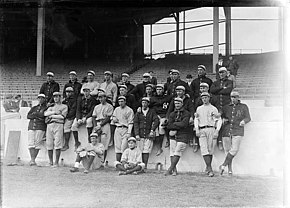
The 1913 squad, the first that went by the name "Yankees"
The history of the New York Yankees Major League Baseball (MLB) team spans more than a century. Frank J. Farrell and William Stephen Devery bought the rights to an American League (AL) club in New York City after the 1902 season. The team, which became known as the Yankees in 1913, rarely contended for the AL championship before the acquisition of outfielder Babe Ruth after the 1919 season. With Ruth in the lineup, the Yankees won their first AL title in 1921, followed by their first World Series championship in 1923. Ruth and first baseman Lou Gehrig were part of the team's Murderers' Row lineup, which led the Yankees to a then-AL record 110 wins and a Series championship in 1927 under Miller Huggins. They repeated as World Series winners in 1928, and their next title came under manager Joe McCarthy in 1932.
The Yankees won the World Series every year from 1936 to 1939 with a team that featured Gehrig and outfielder Joe DiMaggio, who recorded a record hitting streak during New York's 1941 championship season. New York set a major league record by winning five consecutive championships from 1949 to 1953, and appeared in the World Series nine times from 1955 to 1964. Mickey Mantle, Yogi Berra, and Whitey Ford were among the players fielded by the Yankees during the era. After the 1964 season, a lack of effective replacements for aging players caused the franchise to decline on the field, and the team became a money-loser for owners CBS while playing in an aging stadium. (Full article...)
General images - load new batch
-
Image 1The standard fielding positions (from Baseball rules)
-
Image 2In May 2010, the Philadelphia Phillies' Roy Halladay pitched the 20th major league perfect game. That October, he pitched only the second no-hitter in MLB postseason history. (from History of baseball)
-
Image 3An Afghan girl playing baseball in August 2002 (from Baseball)
-
Image 4Diagram indicating the standard layout of positions (from Baseball)
-
Image 5Pesäpallo, a Finnish variation of baseball, was invented by Lauri "Tahko" Pihkala in the 1920s, and after that, it has changed with the times and grown in popularity. Picture of Pesäpallo match in 1958 in Jyväskylä, Finland. (from Baseball)
-
Image 6Fenway Park, home of the Boston Red Sox. The Green Monster is visible beyond the playing field on the left. (from Baseball)
-
Image 7By the 1860s Civil War, baseball (bottom) had overtaken its fellow bat-and-ball sport cricket (top) in popularity within the United States. (from History of baseball)
-
Image 8The typical motion of a right-handed pitcher (from Baseball rules)
-
Image 9The NL champion New York Giants baseball team, 1913. Fred Merkle, sixth in line, had committed a baserunning gaffe in a crucial 1908 game that became famous as Merkle's Boner. (from History of baseball)
-
Image 10Rickey Henderson—the major leagues' all-time leader in runs and stolen bases—stealing third base in a 1988 game (from Baseball)
-
Image 11The American Tobacco Company's line of baseball cards featured shortstop Honus Wagner of the Pittsburgh Pirates from 1909 to 1911. In 2007, the card shown here sold for $2.8 million. (from Baseball)
-
Image 12A runner sliding into home plate and scoring. (from Baseball)
-
Image 13Jackie Robinson in 1945, with the era's Kansas City Royals, a barnstorming squad associated with the Negro American League's Kansas City Monarchs (from Baseball)
-
Image 15Alexander Cartwright, father of modern baseball (from History of baseball)
-
Image 162013 World Baseball Classic championship match between the Dominican Republic and Puerto Rico, March 20, 2013 (from Baseball)
-
Image 17Two players on the baseball team of Tokyo, Japan's Waseda University in 1921 (from Baseball)
-
Image 18A game from the Cantigas de Santa Maria, c. 1280, involving tossing a ball, hitting it with a stick and competing with others to catch it (from History of baseball)
-
Image 19Japanese-Americans spectating a World War II-era game while in an internment camp. America's ties to immigrants and to Japan have been deeply shaped by a shared baseball heritage. (from History of baseball)
-
Image 20Baserunners generally stand a short distance away from their base between pitches, preparing themselves to either go back or steal the next base. (from Baseball rules)
-
Image 21A batter follows through after swinging at a pitched ball. (from Baseball rules)
-
Image 23Sadaharu Oh managing the Japan national team in the 2006 World Baseball Classic. Playing for the Central League's Yomiuri Giants (1959–80), Oh set the professional world record for home runs. (from Baseball)
-
Image 24A well-worn baseball (from Baseball)
-
Image 26Jackie Robinson in 1945, with the era's Kansas City Royals, a barnstorming squad associated with the Negro American League's Kansas City Monarchs (from History of baseball)
-
Image 27A New York Yankees batter (Andruw Jones) and a Boston Red Sox catcher at Fenway Park (from Baseball)
-
Image 28The strike zone, which determines the outcome of most pitches, varies in vertical length depending on the batter's typical height while swinging. (from Baseball rules)
-
Image 29A first baseman receives a pickoff throw, as the runner dives back to first base. (from Baseball)
-
Image 31Cover of Official Base Ball Rules, 1921 edition, used by the American League and National League (from Baseball rules)
-
Image 32Baseball games sometimes end in a walk-off home run, with the batting team usually gathering at home plate to celebrate the scoring of the winning run(s). (from Baseball rules)
-
Image 34A pitcher handing off the ball after being taken out of the game during a mound meeting. (from Baseball)
-
Image 35Sadaharu Oh managing the Japan national team in the 2006 World Baseball Classic. Playing for the Central League's Yomiuri Giants (1959–80), Oh set the professional world record for home runs with 868. (from History of baseball)
-
Image 36The strike zone determines the result of most pitches, and varies in vertical length for each batter. (from Baseball)
-
Image 40Cy Young—the holder of many major league career marks, including wins and innings pitched, as well as losses—in 1908. MLB's annual awards for the best pitcher in each league are named for Young. (from Baseball)
-
Image 41Pick-off attempt on runner (in red) at first base (from Baseball rules)
-
Image 42Diagram of a baseball field Diamond may refer to the square area defined by the four bases or to the entire playing field. The dimensions given are for professional and professional-style games. Children often play on smaller fields. (from Baseball)
-
Image 43Pitchers are generally substituted during mound visits (team gatherings at the pitcher's mound). (from Baseball rules)
-
Image 441906 World Series, infielders playing "in" for the expected bunt and the possible play at the plate with the bases loaded (from Baseball rules)
 Good articles - load new batch
Good articles - load new batch
-
Image 1
John Oscar Dickshot (born John Oscar Dicksus, January 24, 1910 – November 4, 1997), nicknamed "Ugly" Johnny Dickshot, was an American professional baseball left fielder. He played in Major League Baseball for the Pittsburgh Pirates, the New York Giants, and the Chicago White Sox. His professional career, including the seasons he spent in Minor League Baseball, ran from 1930 to 1947. He received the nickname "Ugly" because he proclaimed himself to be "the ugliest man in baseball" during his career.
From Waukegan, Illinois, Dickshot began playing as a semi-professional and in the minor leagues in the early 1930s. He was scouted and signed by the Pirates in 1934, and they promoted him to the major leagues in 1936. The Pirates gave Dickshot a significant role in 1937, but played him sparingly in 1938. A strong season in the minor leagues in 1939 earned him a brief trial with the Giants. Dickshot played in the minor leagues until the White Sox acquired him for the 1944 and 1945 seasons. He returned to the minor leagues in 1946 and his career ended in 1947. (Full article...) -
Image 2
Mark Steven Gubicza (/ˈɡʊbɪzə/; born August 14, 1962), nicknamed "Gubie", is an American former professional baseball pitcher and sportscaster. Gubicza played in Major League Baseball (MLB) for the Kansas City Royals (1984–96) and Anaheim Angels (1997). He is a color commentator for Los Angeles Angels games on Bally Sports West.
After being drafted out of William Penn Charter School in the second round of the 1981 MLB draft and playing three seasons in the minor leagues, Gubicza spent nearly all of his MLB career with the Royals, making all but two of his career appearances with the team. He was a mainstay in the Royals starting rotation for years, earning back-to-back MLB All-Star selections in 1988 and 1989 and making an Opening Day start for the team in 1989. Gubicza played a reduced number of games later in his career due to three arm injuries and a leg injury between 1990 and 1997. He was traded to the Anaheim Angels before the 1997 season and retired after that year. (Full article...) -
Image 3
John Frederick Hiller (born April 8, 1943) is a Canadian former baseball relief pitcher who played 15 seasons in Major League Baseball (MLB) for the Detroit Tigers between 1965 and 1980. A native of Toronto, he joined the Tigers in 1965 and was a member of the 1968 Detroit Tigers team that won the World Series. He set a major league record by starting a game with six consecutive strikeouts in 1968.
In January 1971, Hiller suffered a heart attack and underwent intestinal surgery to control his body's absorption of cholesterol. After missing the 1971 season, Hiller returned in 1972, helping the Tigers win the American League (AL) East title and winning Game 4 of the 1972 AL Championship Series. In 1973, he compiled a 1.44 earned run average (ERA) and broke the major league single-season saves record with 38. The Sporting News awarded Hiller its 1973 Comeback Player of the Year and Fireman of the Year awards. (Full article...) -
Image 4
Paul Raymond "Shorty" Des Jardien (August 24, 1893 – March 7, 1956) was an American football, baseball and basketball player. He played for the University of Chicago where he was selected as the first-team All-American center in both 1913 and 1914 and also pitched a no-hitter for the baseball team. He later played professional baseball for the Cleveland Indians and professional football for the Cleveland Indians (1916), Hammond Pros (1919), Chicago Tigers (1920) and Minneapolis Marines (1922). He was inducted into the College Football Hall of Fame in 1955. (Full article...) -
Image 5
Isaac Benjamin Davis (born March 22, 1987) is an American former professional baseball first baseman. From 2010 through 2016, he played in Major League Baseball (MLB) for the New York Mets, Pittsburgh Pirates, Oakland Athletics, and New York Yankees.
Davis led his high school team to three straight Arizona state championships as a pitcher and first baseman. As a hitter he batted .447, while as a pitcher he recorded a 23–0 win–loss record, a 1.85 earned run average (ERA), and 14 saves. He also pitched for the gold medal-winning U.S.A. Youth National Team in the 2003 World Youth Championships, and was the most valuable player of the 2004 AFLAC All-American High School Baseball Classic. (Full article...) -
Image 6
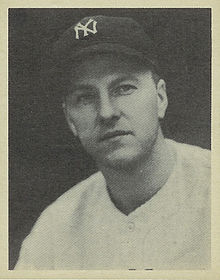
Montgomery Marcellus Pearson (September 2, 1908 – January 27, 1978) was an American baseball pitcher who played ten seasons in Major League Baseball (MLB). Nicknamed "Hoot", he played for the Cleveland Indians, New York Yankees and Cincinnati Reds from 1932 to 1941. He batted and threw right-handed and served primarily as a starting pitcher.
Pearson played minor league baseball for three different teams until 1932, when he signed with the Cleveland Indians. After spending four seasons with the organization, Pearson was traded to the New York Yankees, where he spent the next five years. At the conclusion of the 1940 season, he was traded to the Cincinnati Reds, with whom he played his last game on August 5, 1941. A four-time World Series champion, Pearson holds the MLB record for lowest walks plus hits per inning pitched (WHIP) in the postseason. He is noted for pitching the first no-hitter at the original Yankee Stadium. (Full article...) -
Image 7
Tyler Lee Clippard (born February 14, 1985) is an American former professional baseball pitcher. He played in Major League Baseball (MLB) for the New York Yankees, Washington Nationals, Oakland Athletics, New York Mets, Arizona Diamondbacks, Chicago White Sox, Houston Astros, Toronto Blue Jays, Cleveland Indians, and Minnesota Twins.
After playing baseball at J. W. Mitchell High School in New Port Richey, Florida, the Yankees drafted Clippard in the ninth round of the 2003 MLB draft. He debuted with the Yankees as a starting pitcher in 2007. After being traded to the Washington Nationals he was named to the MLB All-Star Game in 2011 and 2014 and won the MLB Delivery Man of the Month Award in June 2011. (Full article...) -
Image 8
John D. Naylor (August 10, 1893 – February 8, 1955) was an American athlete and college sports coach. He was best known as an athletics director and multi-sport coach at Beacom College, where he served from 1922 to 1952. Before his coaching career, Naylor was a baseball, basketball, and football player in several low-level minor leagues.
A native of New Castle, Delaware, Naylor was a multi-sport athlete in high school, before attending college at the University of Delaware. Following two years in college, he started a semi-professional baseball career with the Milford Caulks in c. 1914. He also spent time with seven other minor league teams between 1916 and 1923. He started a coaching career in 1920 as a player-coach with a Brandywine basketball team and the St. Mary's baseball team. In 1922, he became the athletic director, baseball coach, and basketball coach at Beacom College, where he spent the next 30 years. He retired in 1952. (Full article...) -
Image 9

Andrew Bernard "Barney" Gilligan (January 3, 1856 – April 1, 1934) was an American professional baseball player whose career spanned 12 seasons, 11 of which were spent with the Major League Baseball (MLB) Cleveland Blues (1879–1880), Providence Grays (1881–1885), Washington Nationals (1886–1887), and Detroit Wolverines (1888). Gilligan, who predominately played as a catcher, also played as an outfielder and a shortstop. Over his career, Gilligan compiled a career batting average of .207 with 217 runs scored, 388 hits, 68 doubles, 23 triples, three home runs, and 167 runs batted in (RBI) in 523 games played. Although the majority of his career was spent in the major leagues, Gilligan also played in minor league baseball. He was listed as standing 5 feet 6 inches (168 cm) and weighing 130 pounds (59 kg). (Full article...) -
Image 10Lawrence William Kennedy (May 1917 – March 4, 1995) was an American professional baseball player. A left-handed pitcher, he played two seasons in the minor leagues with the Mayfield Clothiers, Siloam Springs Travelers and Lincoln Links, and was known for going from living at Father Flanagan's Boys' Home in Boys Town, Nebraska, to playing professional baseball. He also twice served as the mayor of Boys Town, and was for a time their police commissioner as well as director of public safety. (Full article...)
-
Image 11

Arnold Ray McBride (born February 3, 1949), nicknamed "Shake 'n Bake" and "the Callaway Kid", is an American former professional baseball outfielder, who played in Major League Baseball (MLB) for the St. Louis Cardinals, Philadelphia Phillies, and Cleveland Indians between 1973 and 1983. He had the most success with the Phillies teams of the late 1970s and early 1980s.
After attending Fulton High School and Westminster College in Missouri, McBride debuted for the Cardinals in 1973. He was the 1974 National League Rookie of the Year, and subsequently represented the National League (NL) in the 1976 MLB All-Star Game. McBride was a member of the world champion 1980 Phillies team, hitting a three-run home run in the first game of that year's World Series. (Full article...) -
Image 12
Howard Earle "Twink" Twining (May 30, 1894 – June 14, 1973) was an American professional baseball pitcher who played one game in Major League Baseball (MLB) for the Cincinnati Reds. He played baseball and basketball at Swarthmore College and later became a prominent dermatologist. (Full article...) -
Image 13
Robert Gibson (November 9, 1935 – October 2, 2020), nicknamed "Gibby" and "Hoot", was an American baseball pitcher in Major League Baseball who played his entire career for the St. Louis Cardinals from 1959 to 1975. Known for his fiercely competitive nature, Gibson tallied 251 wins, 3,117 strikeouts, and a 2.91 earned run average. A nine-time All-Star and two-time World Series Champion, he won two Cy Young Awards and the 1968 National League Most Valuable Player Award.
Born in Omaha, Nebraska, Gibson overcame childhood illness to excel in youth sports, particularly basketball and baseball. After briefly playing with the Harlem Globetrotters basketball team, he chose to pursue baseball and signed with the St. Louis Cardinals organization. He became a full-time starting pitcher in July 1961 and earned his first All-Star appearance in 1962. Gibson won 2 of 3 games he pitched in the 1964 World Series, then won 20 games in a season for the first time in 1965. Gibson also pitched three complete game victories in the 1967 World Series. He is one of four players and two pitchers to win multiple World Series MVPs. (Full article...) -
Image 14Thomas Reid Nichols (born August 5, 1958) is an American former outfielder and coach in Major League Baseball (MLB). He played for the Boston Red Sox (1980–1985), Chicago White Sox (1985–1986), and Montreal Expos (1987). Listed at 6 feet 0 inches (1.83 m) and 195 pounds (88 kg), he batted and threw right-handed. After his playing career ended, he served as a coach and minor league coordinator for the Baltimore Orioles, Texas Rangers, and Milwaukee Brewers.
Though he did not watch professional baseball growing up, Nichols started playing Little League Baseball at age 11 and drew interest from the Red Sox and the Los Angeles Dodgers when he graduated high school. The Red Sox selected him in the 12th round (286th overall) of the 1976 MLB draft, and he debuted with them in 1980. Though never an everyday starter, he batted a career-high .302 in 1982 and played a career-high 100 games in 1983. In 1985, he was traded to the White Sox, remaining with them through the 1986 season. Nichols played for the Expos in 1987, spent part of 1988 in the Texas Rangers organization, and joined the Chicago Cubs for 1989 spring training before retiring. (Full article...) -
Image 15Alva Lee Holloman (March 7, 1923 – May 1, 1987), nicknamed "Bobo", was an American right-handed pitcher in Major League Baseball (MLB), who played in one season with the American League (AL) St. Louis Browns, in 1953. In 22 career games, he pitched 65+1⁄3 innings and posted a win–loss record of 3–7, with a 5.23 earned run average (ERA).
Born in Thomaston, Georgia, Holloman served in World War II before starting his professional baseball career. From 1946 to 1952, he gradually rose up through the minor leagues, and got a spring training invitation from the Chicago Cubs in 1950. (Full article...)
Did you know (auto-generated) - load new batch

- ... that one Baltimore Orioles player compared the 2024 Major League Baseball jerseys to knockoffs from TJ Maxx?
- ... that Cam Booser retired from baseball to work as a carpenter in 2017 and made it to Major League Baseball in 2024?
- ... that before his Major League Baseball career, Leo Posada represented Cuba internationally in cycling?
- ... that Zack Kelly received a $500 signing bonus, lost money in his first professional seasons, and was released by two organizations before he made his Major League Baseball debut?
- ... that Harry Booth played for, captained, and coached the Saint Joseph's Hawks baseball and men's basketball teams?
- ... that Cy Block and Ross Horning testified before the United States Congress about how the reserve clause limited their careers in professional baseball?
- ... that the six highest Minor League Baseball season attendance counts were all at Sahlen Field?
- ... that Puerto Rico's Willie Hernández became the highest paid player in Detroit Tigers history after winning Cy Young and Most Valuable Player awards and a World Series?
Quotes
| Two-thirds of the Earth is covered by water. The other third is covered by Garry Maddox.
— Ralph Kiner, broadcaster for the New York Mets
|
 Featured lists - load new batch
Featured lists - load new batch
-
Image 1

Randy Johnson, the Opening Day starter from 1999 to 2004
The Arizona Diamondbacks are a Major League Baseball (MLB) franchise based in Phoenix, Arizona. They play in the National League West division. The first game of the new baseball season for a team is played on Opening Day, and being named the Opening Day starter is an honor, which is often given to the player who is expected to lead the pitching staff that season, though there are various strategic reasons why a team's best pitcher might not start on Opening Day. The Diamondbacks have used 10 different Opening Day starting pitchers in their 21 seasons. The 10 starters have a combined Opening Day record of eight wins, seven losses (8–7), and six no decisions. No decisions are only awarded to the starting pitcher if the game is won or lost after the starting pitcher has left the game.
Randy Johnson holds the Diamondbacks' record for most Opening Day starts with six, and has an Opening Day record of 3–2. Brandon Webb started four Opening Days, and Ian Kennedy has been the Opening Day starter thrice. Andy Benes, Javier Vázquez, Dan Haren, and Wade Miley have started one Opening Day each. Kennedy has the best winning percentage as the Opening Day starting pitcher with a record of 2–0. Benes, Vázquez, and Miley are tied for the worst Opening Day record, at 0–1. Webb is Arizona's only pitcher with multiple no-decisions on Opening Day (three), and Johnson is the only pitcher to have won three or more opening games. (Full article...) -
Image 2
The Edgar Martínez Outstanding Designated Hitter Award, commonly referred to as the Edgar Martínez Award and originally known as the Outstanding Designated Hitter Award, has been presented annually to the most outstanding designated hitter (DH) in Major League Baseball (MLB) since 1973. The award is voted on by club beat reporters, broadcasters, and public relations departments. The Associated Press discontinued the award in 2000, but it was picked up by the Baseball Writers' Association of America, which has administered it since. All players with a minimum of 100 at bats at DH are eligible. From the award's inception in 1973 until 2019, and in 2021, use of the designated hitter was allowed only in the American League (AL).
In September 2004, at Safeco Field (now T-Mobile Park) ceremonies in honor of Edgar Martínez, Commissioner Bud Selig announced that the award would be renamed for the five-time recipient (1995, 1997–98, 2000–01). In an 18-year career with the Seattle Mariners, primarily as a designated hitter, Martínez batted .312, with 309 career home runs and 1,261 runs batted in. (Full article...) -
Image 3First-round selections Ken Griffey Jr. (top left), Mike Harkey (top right), Jack McDowell (bottom left), and Mike Remlinger (bottom right).
The 1987 Major League Baseball draft is the process by which Major League Baseball (MLB) teams select athletes to play for their organization. High school seniors, college juniors and seniors, and anyone who had never played under a professional contract were considered eligible for the draft. The 1987 MLB Draft took place as a conference call to the Commissioner of Baseball's office in New York from June 2–4. As opposed to the National Football League Draft which appeared on ESPN, no network aired the MLB Draft.
The American League (AL) and the National League (NL) alternated picks throughout the first round; because an NL team drafted first in the 1986 MLB Draft, an AL team had the first selection in 1987. Having finished 67–95 in 1986, the Seattle Mariners had the worst record in the AL and thus obtained the first overall selection. The second selection went to the Pittsburgh Pirates, who had the worst record in the NL. (Full article...) -
Image 4

Orlando Hernández won gold with the Cuban team in the 1992 Summer Olympics, baseball's first appearance as an Olympic medal sport.
Baseball is a sport formerly contested at the Summer Olympic Games. It was originally played as a demonstration sport in seven Olympics—1912, 1936, 1952, 1956, 1964, 1984, and 1988— more than for any other sport in Olympic history. These exhibitions featured a single game at the first five Olympic appearances and then a tournament format in 1984 and 1988. The International Olympic Committee (IOC) granted baseball official status on October 13, 1986, for the 1992 Summer Olympics. The sport was contested at each subsequent Games through 2008, after which the IOC removed it from the roster of Olympic sports.
In 1992, the first official Olympic baseball tournament was won by the Cuban team. Cuba had boycotted the 1984 and 1988 Olympics, missing the previous exhibition baseball tournaments, but entered in 1992 as the favorite, having won the past 12 world championships and with a 62–1 record in international competitions since 1986. The Cubans went undefeated in the 1992 Olympics and trailed in only one game. They went undefeated again at the 1996 Olympics en route to a second consecutive gold medal. The United States won their first medal (bronze) in the 1996 Olympics and then won gold at the 2000 Summer Olympics. 2000 was the first Olympics in which Cuba lost a game: first to the Dutch team in round-robin play and then again to the Americans in the gold medal game. This was also the first time professional players were allowed to compete in baseball, though Major League Baseball (MLB) did not permit any player on the 40-man roster of an MLB team to compete. In 2004, the reigning gold medalist United States did not qualify for the Olympic tournament, while the Cuban team won its third gold medal. (Full article...) -
Image 5

Greg Maddux has won 18 Gold Gloves, the most in Major League Baseball history.
The Gold Glove Award is the award given annually to the Major League Baseball players judged to have exhibited superior individual fielding performances at each fielding position in both the National League (NL) and the American League (AL), as voted by the managers and coaches in each league. Managers are not permitted to vote for their own players. Eighteen Gold Gloves are awarded each year (with the exception of 1957, 1985, 2007 and 2018), one at each of the nine positions in each league. In 1957, the baseball glove manufacturer Rawlings created the Gold Glove Award to commemorate the best fielding performance at each position. The award was created from a glove made from gold lamé-tanned leather and affixed to a walnut base. Initially, only one Gold Glove per position was awarded to the top fielder at each position in the entire league; however, separate awards were given for the National and American Leagues beginning in 1958.
Greg Maddux has won the most Gold Glove Awards among all players, including pitchers, in Major League Baseball history. He won 18 awards, all in the National League; his streak of wins was consecutive from 1990 through 2002 until interrupted by Mike Hampton in 2003. Maddux won five more awards from 2004 to 2008, after which he retired. Jim Kaat is second and held the record for most wins (16) until he was displaced by Maddux in 2007. He won 14 awards in the American League and 2 in the National League; his 16 consecutive awards is a record among winners. Bob Gibson won nine Gold Gloves with the St. Louis Cardinals, and the inaugural winner Bobby Shantz won four awards in each league, for a total of eight. Mark Langston and Mike Mussina are tied for the fifth-highest total, with seven wins each. Zack Greinke currently ranks seventh with six wins. Gold Glove winners at pitcher who have been inducted into the Baseball Hall of Fame include Gibson, Kaat, Mussina, Maddux, Steve Carlton, Jim Palmer, and Phil Niekro. (Full article...) -
Image 6

1998 Rookie of the Year Award winner Kerry Wood is one of two Cubs first-round draft picks so honored.
The Chicago Cubs are a Major League Baseball (MLB) franchise based in Chicago, Illinois. They play in the National League Central division. Since the institution of MLB's Rule 4 Draft, the Cubs have selected 68 players in the first round. Officially known as the "First-Year Player Draft", the Rule 4 Draft is MLB's primary mechanism for assigning amateur baseball players from high schools, colleges, and other amateur baseball clubs to its teams. The draft order is determined based on the previous season's standings, with the team possessing the worst record receiving the first pick. In addition, teams which lost free agents in the previous off-season may be awarded compensatory or supplementary picks.
Of the 68 players picked in the first round by the Cubs, 32 have been pitchers, the most of any position; 24 of these were right-handed, while 6 were left-handed. Sixteen players picked in the initial round were outfielders, while ten shortstops, two catchers, and one player each at first base, second base, and third base were also taken. The Cubs drafted 26 players out of high school, and 32 out of college. Chicago has drafted eleven players from high schools or colleges in the state of California, with six more coming from Texas and five from Indiana. The Cubs have also taken four players from their home state of Illinois. (Full article...) -
Image 7

Alex Cora (waving) is the most recent manager to lead the Red Sox to a World Series championship.
The Boston Red Sox are a professional baseball team based in Boston, Massachusetts. The Red Sox are members of the American League (AL) East Division in Major League Baseball (MLB). They have competed since 1901, initially as the Boston Americans (1901–1907), and under their current name since 1908. Since 1912, the Red Sox have played their home games at Fenway Park. In baseball, the head coach of a team is called the manager, or more formally, the field manager. There have been 48 different managers in franchise history; the current manager is Alex Cora, who previously managed the team during the 2018 and 2019 seasons and was re-hired by the team on November 6, 2020.
Jimmy Collins was the first manager of the franchise, managing from 1901 to 1906. Among all Red Sox managers, Joe Cronin managed the most regular season games (2,007) and registered the most regular season wins (1,071), while Terry Francona managed the most playoff games (45) and registered the most playoff wins (28). The most World Series championships won by a Red Sox manager is two, accomplished by Bill Carrigan (1915 and 1916) and Francona (2004 and 2007). John McNamara and Jimy Williams are the only two Red Sox managers to win the AL Manager of the Year Award, in 1986 and 1999, respectively. (Full article...) -
Image 8The Hutch Award is given annually to an active Major League Baseball (MLB) player who "best exemplifies the fighting spirit and competitive desire" of Fred Hutchinson, by persevering through adversity. The award was created in 1965 in honor of Hutchinson, the former MLB pitcher and manager, who died of lung cancer the previous year. The Hutch Award was created by Hutch's longtime friends Bob Prince, a broadcaster for the Pittsburgh Pirates and KDKA; Jim Enright, a Chicago sportswriter; and Ritter Collett, the sports editor of the Dayton Journal Herald. They also created a scholarship fund for medical students engaged in cancer research to honor Hutchinson's memory.
Eleven members of the National Baseball Hall of Fame have won the Hutch Award. The inaugural winner was Mickey Mantle. Danny Thompson, the 1974 recipient, was diagnosed with leukemia earlier that year. He continued to play through the 1976 season before dying that December at the age of 29. Jon Lester won the award in 2008 after recovering from anaplastic large-cell lymphoma. (Full article...) -
Image 9
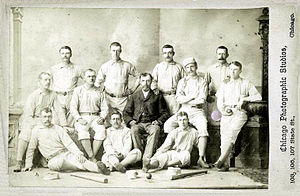
1882 Providence Grays
The Providence Grays were a Major League Baseball franchise based in Providence, Rhode Island from 1878 to 1885. During the team's eight seasons in the National League (NL), which then comprised eight teams, they finished third place or higher in the final standings seven times, and won the league championship in both 1879 and 1884. Providence played their home games at the Messer Street Grounds, which was located in the Olneyville neighborhood of Providence. The Grays were officially organized on January 16, 1878 by Benjamin Douglas, who became the team's general manager. Henry Root was hired as the team president‚ and Tom Carey was initially hired to be the on-field captain, whose duties were similar to the modern-day manager. On January 21, 1878, Providence applied for membership in the NL, and was officially approved on February 6. On April 10, Root took over ownership of the team, fired Douglas for incompetence and insubordination, and hired Tom York to replace Carey as captain.
Providence was successful in signing several star players for their inaugural season: Paul Hines had played the previous four seasons with the Chicago White Stockings; Tom Carey was signed after the Hartford Dark Blues folded; Doug Allison was the catcher for the 1869 Cincinnati Red Stockings, who had an 84-game winning streak from 1869 to 1870; and John Montgomery Ward, who was playing his first season in the major leagues. Ward had a win–loss record of 22–13 and Hines led the league in home runs, runs batted in (RBIs), and batting average as the Grays finished in third place among the six teams in the NL for the 1878 season, with a record of 33 wins, 27 losses, and 2 ties. The Grays won the NL championship in 1879, placing first among the league's eight teams with Ward winning 47 games as their starting pitcher, and the leadership of George Wright, who played second base and also managed. The team had a strong hitting line-up with Hines' league leading .357 batting average, as well as new additions Jim O'Rourke and Joe Start, who both had batting averages over .300. William Edward White, a Brown University player who played one game for the Grays on June 21, 1879, may have been the first African-American to play at the major league level; according to Peter Morris of the Society for American Baseball Research, the evidence for White is strong, but not conclusive. If this claim is true, then White pre-dated both Moses Fleetwood Walker and his brother Weldy Walker, who both played for the 1884 Toledo Blue Stockings of the American Association (AA). In 1880, the Grays finished in second place among the eight NL teams, with Ward winning 39 games. On June 17 of that year, Ward pitched the second perfect game in major league history. (Full article...) -
Image 10The Major League Baseball Comeback Player of the Year Award is presented by Major League Baseball (MLB) to the player who is judged to have "re-emerged on the baseball field during a given season." The award was developed in 2005, as part of a sponsorship agreement between MLB and Viagra. In 2005 and 2006 representatives from MLB and MLB.com selected six candidates each from the American (AL) and National Leagues (NL) and one winner for each league was selected via an online poll on MLB.com. Since then, the winners have been selected by a panel of MLB beat reporters. Under the current voting structure, first place votes are worth five points, second place votes worth three, and third place votes worth one with the award going to the player with the most points overall. Past winners have often overcome injury or personal problems en route to their award-winning season.
A Comeback Player of the Year Award has been given by The Sporting News since 1965 but its results are not officially recognized by Major League Baseball. Since the beginning of the MLB award in 2005, the recipients have been identical with the following exceptions: 2008 NL (TSN honored Fernando Tatís, MLB honored Brad Lidge), 2010 AL (TSN honored Vladimir Guerrero, MLB honored Francisco Liriano), 2012 AL (TSN honored Adam Dunn, MLB honored Fernando Rodney), 2016 (TSN honored Jose Fernandez and Mark Trumbo, MLB honored Anthony Rendon and Rick Porcello), 2018 NL (TSN honored Matt Kemp, MLB honored Jonny Venters), 2019 AL (TSN honored Hunter Pence, MLB honored Carlos Carrasco), and 2020 AL (TSN honored Carrasco, MLB honored Salvador Pérez). Liriano and Posey are the only players to win the MLB award multiple times with Liriano being the first to win it in each league. (Full article...) -
Image 11

Mike Mussina (1990) made five all-star appearances with the Orioles.
The Baltimore Orioles are a Major League Baseball (MLB) franchise based in Baltimore, Maryland. They play in the American League East division. Since the institution of MLB's Rule 4 Draft, the Orioles have selected 60 players in the first round. Officially known as the "First-Year Player Draft", the Rule 4 Draft is MLB's primary mechanism for assigning amateur baseball players from high schools, colleges, and other amateur baseball clubs to its teams. The draft order is determined based on the previous season's standings, with the team possessing the worst record receiving the first pick. In addition, teams which lost free agents in the previous off-season may be awarded compensatory or supplementary picks.
Of the 60 players picked in the first round by Baltimore, 30 have been pitchers, the most of any position; 21 of them were right-handed, while 9 were left-handed. Twelve outfielders, eight shortstops, seven catchers, two third basemen, and one second basemen were also taken. The team has never drafted a player at first base. 16 of the players came from high schools or universities in the state of California, and Florida follows with five players. The Orioles have also drafted two players from Canada, Ntema Ndungidi (1997) and Adam Loewen (2002). The Orioles have not drafted any players from their home state of Maryland. (Full article...) -
Image 12

In the first World Series in 1903, the Boston Americans (front row) defeated the Pittsburgh Pirates (back row) 5–3 in an eight-game series.
The World Series is the annual championship series of Major League Baseball (MLB) and concludes the MLB postseason. First played in 1903, the World Series championship is a best-of-seven playoff and is a contest between the champions of baseball's National League (NL) and American League (AL). Often referred to as the "Fall Classic", the modern World Series has been played every year since 1903 with two exceptions: in 1904, when the NL champion New York Giants declined to play the AL champion Boston Americans; and in 1994, when the series was canceled due to the players' strike. The best-of-seven style has been the format of all World Series except in 1903, 1919, 1920, 1921, when the winner was determined through a best-of-nine playoff. Although the large majority of contests have been played entirely during the month of October, a small number of Series have also had games played during September and November. The Series-winning team is awarded the Commissioner's Trophy. Players, coaches and others associated with the team are generally given World Series rings to commemorate their victory; however, they have received other items such as pocket watches and medallions in the past. The winning team is traditionally invited to the White House to meet the President of the United States.
A total of 120 World Series have been contested through 2024, with the AL champion winning 68 and the NL champion winning 52. The New York Yankees of the AL have played in 41 World Series, winning 27 – the most championship appearances and most victories by any MLB team. The Dodgers and the Yankees are tied for the most losses with 14 each. The St. Louis Cardinals have won 11 championships, the most among NL clubs and second-most all-time behind the Yankees. The Dodgers have represented the NL the most in the World Series with 22 appearances. The Seattle Mariners are the only MLB franchise that has never appeared in a World Series; the Milwaukee Brewers, San Diego Padres, Tampa Bay Rays, and Colorado Rockies have all played in the Series but have never won it, with the Padres and the Rays appearing twice. The Los Angeles Angels and Washington Nationals are the only teams who have won their only World Series appearance, and the Toronto Blue Jays and Miami Marlins are the only teams with multiple World Series appearances with no losses. The Toronto Blue Jays are the only franchise from outside the United States to appear in and win a World Series, winning in 1992 and 1993. The Houston Astros are the only franchise to have represented both the NL (2005) and the AL (2017, 2019, 2021, 2022), winning the Series in 2017 and 2022. The 1919 and 2017 World Series were both marred with cheating scandals: the Black Sox Scandal and the Houston Astros sign stealing scandal. The most recent World Series champions are the Los Angeles Dodgers. (Full article...) -
Image 13The Pittsburgh Pirates are a Major League Baseball (MLB) franchise based in Pittsburgh, Pennsylvania. They play in the National League Central division. Since the establishment of the Rule 4 Draft the Pirates have selected 72 players in the first round. Officially known as the "First-Year Player Draft", the Rule 4 Draft is MLB's primary mechanism for assigning players from high schools, colleges, and other amateur clubs to its franchises. The draft order is determined based on the previous season's standings, with the team possessing the worst record receiving the first pick. In addition, teams which lost free agents in the previous off-season may be awarded compensatory or supplementary picks.
Of these 72 players, 27 have been pitchers, the most of any position; 20 of these were right-handed, while 7 were left-handed. 17 outfielders and 15 shortstops were selected. The Pirates have also drafted 7 catchers, 3 first basemen, and 3 third basemen, but have never selected a second baseman in the first round. Eleven players came from high schools or universities in the state of California, while eight came from Florida. (Full article...) -
Image 14

Todd Worrell (1982) is the only Cardinals first-round draft pick to win the Rookie of the Year Award.
The St. Louis Cardinals are a Major League Baseball (MLB) franchise based in St. Louis, Missouri. They play in the National League Central division. Since the institution of MLB's Rule 4 Draft, the Cardinals have selected 77 players in the first round. Officially known as the "First-Year Player Draft", the Rule 4 Draft is MLB's primary mechanism for assigning amateur baseball players from high schools, colleges, and other amateur baseball clubs to its teams. The draft order is determined based on the previous season's standings, with the team possessing the worst record receiving the first pick. In addition, teams which lost free agents in the previous off-season may be awarded compensatory or supplementary picks.
Of the 77 players picked in the first round by St. Louis, 39 have been pitchers, the most of any position; 30 of them were right-handed, while nine were left-handed. Eight outfielders, ten third basemen, six shortstops, six first basemen, five catchers, and two second basemen were taken as well. The team also drafted one player, Leron Lee (1966), who played as an infielder. 16 of the players came from high schools or universities in the state of California, and Texas and Arizona follow with seven and six players. The Cardinals have not drafted any players from their home state of Missouri. (Full article...) -
Image 15

Ken Griffey Jr. playing for the Mariners in June 2009. Griffey Jr. holds five single-season batting records and an individual career record for the Mariners franchise.
The Seattle Mariners are a Major League Baseball (MLB) team who have participated in 46 seasons since their inception in 1977. Through July 16, 2022, they have played 7,156 games, winning 3,385, losing 3,769, and tying two, for a winning percentage of .473. This list documents the superlative records and accomplishments of team members during their tenures as Seattle Mariners in Major League Baseball's American League West.
Ichiro Suzuki holds the most franchise records as of the end of the 2012 season, with ten, including best single-season batting average, most career hits, and most career triples. He is followed by Edgar Martínez, who holds nine records, including best career on-base percentage and the single-season walk record. (Full article...)
More did you know
- ... that Negro league baseball executive Cum Posey organized the East-West League in 1932, but the league folded before the end of the season?
- ... that Freeman Fitzgerald played football with Knute Rockne and once struck out 19 batters in a baseball game?
- ... that despite being named one of the "top prospects of the decade" by Baseball America, American baseball pitcher Nick Neugebauer compiled a career record of just two wins and eight losses?
- ... that Milwaukee Brewers baseball player Dan Thomas was called the "Sundown Kid" because he refused to play on Sabbath?
- ... that when Roger Bresnahan adopted the use of shin guards in Major League Baseball on Opening Day in 1907, angry fans threw snow onto the field?
Sports portals
Selected picture
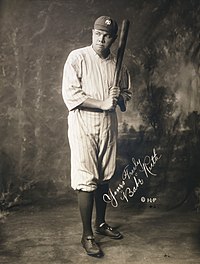
| Credit: Irwin, La Broad, & Pudlin. |
George Herman Ruth, Jr. (February 6, 1895 – August 16, 1948), also popularly known as "Babe", "The Bambino", and "The Sultan of Swat", was an American Major League baseball player from 1914–1935. Ruth originally broke into the Major Leagues with the Boston Red Sox as a starting pitcher, but after he was sold to the New York Yankees in 1919, he converted to Right Field and subsequently became one of the league's most prolific hitters. Ruth was a mainstay in the Yankees' lineup that won 7 pennants and 4 World Series titles during his tenure with the team. After a short stint with the Boston Braves in 1935, Ruth retired. In 1936, Ruth became one of the first five players elected to the Baseball Hall of Fame.
Associated Wikimedia
The following Wikimedia Foundation sister projects provide more on this subject:
-
Commons
Free media repository -
Wikibooks
Free textbooks and manuals -
Wikidata
Free knowledge base -
Wikinews
Free-content news -
Wikiquote
Collection of quotations -
Wikisource
Free-content library -
Wikiversity
Free learning tools -
Wiktionary
Dictionary and thesaurus
More portals
- Portals with triaged subpages from June 2018
- All portals with triaged subpages
- Portals with no named maintainer
- Automated article-slideshow portals with 51–100 articles in article list
- Automated article-slideshow portals with 501–1000 articles in article list
- Random portal component with 41–50 available subpages
- Automated article-slideshow portals with 201–500 articles in article list
- Random portal component with 11–15 available subpages
- Random portal component with 21–25 available image subpages

